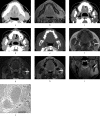Perineural spread of adenoid cystic carcinoma in the oral and maxillofacial regions: evaluation with contrast-enhanced CT and MRI
- PMID: 22301639
- PMCID: PMC3520370
- DOI: 10.1259/dmfr/21825064
Perineural spread of adenoid cystic carcinoma in the oral and maxillofacial regions: evaluation with contrast-enhanced CT and MRI
Abstract
Objectives: The objective of this study was to compare the accuracy of contrast-enhanced CT (CECT) and contrast-enhanced MRI (CEMRI) in the detection of perineural spread (PNS) of adenoid cystic carcinoma (ACC) in the oral and maxillofacial regions.
Methods: This study consisted of 13 ACCs from 13 patients, all of which were histopathologically diagnosed. Both CECT and CEMRI were performed in all patients before the treatment. The images of each patient were retrospectively evaluated for the detection of PNS. The definitions of PNS included abnormal density/signal intensity, contrast enhancement or widening of the pterygopalatine fossa, palatine foramen, incisive canal, mandibular foramen and mandibular canal, and enlargement or excessive contrast enhancement of a nerve.
Results: 11 out of 13 cases were proven to exhibit PNS histopathologically. 8 of the 11 cases for which PNS was histopathologically proven exhibited PNS on MR images. Six of the eight cases for which PNS was exhibited on MR images also exhibited PNS on CT images. The sensitivity, specificity and accuracy for the detection of PNS were 55%, 100% and 62% on CT images and 73%, 100% and 77% on MR images, respectively. Although the accuracy of PNS on MR images was slightly superior to that on CT images, there were no statistically significant differences between the detection of PNS on CT images and on MR images.
Conclusions: CT and MR images are equally useful for the detection of PNS of ACC in the oral and maxillofacial regions.
Figures




References
-
- Kim KH, Sung MW, Chung PS, Rhee CS, Park CI, Kim WH. Adenoid cystic carcinoma of the head and neck. Arch Otolaryngol Head Neck Surg 1994;120:721–726 - PubMed
-
- Iseli TA, Karnell LH, Graham SM, Funk GF, Buatti JM, Gupta AK, et al. Role of radiotherapy in adenoid cystic carcinoma of the head and neck. J Laryngol Otol 2009;123:1137–1144 - PubMed
-
- Spiro RH, Huvos AG, Strong EW. Adenoid cystic carcinoma of salivary origin. A clinicopathologic study of 242 cases. Am J Surg 1974;128:512–520 - PubMed
-
- Hanna E, Vural E, Prokopakis E, Carrau R, Snyderman C, Weissman J. The sensitivity and specificity of high-resolution imaging in evaluating perineural spread of adenoid cystic carcinoma to the skull base. Arch Otolaryngol Head Neck Surg 2007;133:541–545 - PubMed
-
- Arcas A, Bescos S, Raspall G, Capellades J. Perineural spread of epidermoid carcinoma in the infraorbital nerve: case report. J Oral Maxillofac Surg 1996;54:520–522 - PubMed
Publication types
MeSH terms
Substances
LinkOut - more resources
Full Text Sources
Medical

